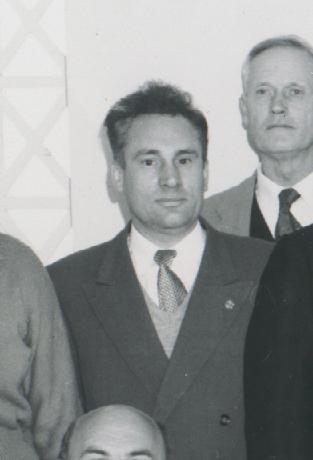
Note: If you have suggestions or corrections, do send them to cowley@umich.edu. New results will be found at the end of the file.
It is generally acknowledged that the spectrum of HD 101065 may be the most unusual of all stellar spectra. Its discoverer, the Polish-Australian astronomer, Antoni Przybylski, described the object in a letter to Nature in 1961 as "A G0 Star with High Metal Content." He had only relatively low dispersion at the time, and much of his discussion was devoted to photoelectric measurements that were similar to early G stars. Only the H and K lines of Ca II, and the hydrogen lines were identified with certainty. In 1963 (PASP 75, 349), Przybylski and Kennedy described spectra of the star taken with moderate spectral resolution (36A/mm), which allowed them to confirm how truly unusual the stellar spectrum was.

This image (courtesy of of Mike Bessell) shows Przybylski in the early 1960's, about the time the world learned of his most unusual star. I met him at the IAU in 1964, and took the opportunity to extract a critical piece of information: would you pronounce your name for me--very slowly. He obliged me, and I thought I detected a slight "puff" at the beginning of the sound, which Mike Bessel writes is like "jebilskee", with the "je" as if it were in French. The initial "P" gets minimal sound.
Przybylski was born in Poland in 1913, and attended the University of Posnan. He served as an artillary officer in the Polish army, at the outbreak of WW II, and was taken prisoner by the Germans. He escaped from a prison camp in Mecklenberg, and succeeded in making his way to Switzerland, where he was interned along with other Polish servicemen. He earned a doctorate in ``Technical Sciences'' from the Zurich Polytechnic, with a dissertation on the chemistry of copper (not holmium). He emmigrated to Australia in 1950, and did a PhD in astronomy under Sir Richard Woolley. He served on the staff of the Mount Stromlo Observatory until his retirement in the 1980's. He died in 1984.
S.C.B. Gascoigne, who wrote his obituary for the Quarterly Journal (Vol. 27, p. 697) noted that
Astronomically he was a real independent, found his own problems, and once he had made up his mind held to it very firmly. Thus, criticized a good deal for his advocacy of holmium as a major constituent of HD 101065, he never budged, and of course he was right.
I had it from an inside source many years ago, that Przybylski told the physicists at the National Bureau of Standards they had probably misclassified two strong holmium lines as belonging to the neutral atom. All of the other lines of lanthanides in his star were from the singly ionized species, hence, he suggested an error. The two lines may be found in NBS Monograph 32 (Meggers, Corliss, and Scribner 1961), listed as Ho I 3796.75, and 3810.73. They are the third and fourth strongest lines of the holmium spectrum listed in Monograph 32. In the revision of this work, (Monograph 145, 1975) the lines were reclassified as Ho II.
Apart from hydrogen and Ca II H and K, the strongest lines in HD 101065 are due to singly ionized lanthanides. Some lines from the third spectra (doubly ionized atoms) are present, but there is only marginal evidence of the presence of lines from any neutral lanthanides. Lines from neutral and first-ionized elements of the iron group are weakly present, but so badly blended that Przybylski maintained they might not be present at all.
In the published version of IAU Colloquium 32 Physics of Ap-Stars (ed. Weiss, Jenkner, and Wood, 1976), there is an interesting discussion by Przybylski and others (p. 747 ff.) At the end of the exchange, Georges Michaud remarks that he has had "the impression of being at a museum of horrors or perhaps errors."
Hipparchos measurements confirm that HD 101065 is a dwarf, or subgiant, and therefore not a highly evolved object, even though its spectrum is in many ways similar to the S-stars, whose atmospheres are enriched with recently synthesized material from deep within their interiors. In 1974, Gary Wegner and A. D. Petford published a remarkable paper claiming that Przybylski's star was a cool, extreme member of a class of objects well known to astronomical spectroscopists as Ap stars. Like HD 101065, the Ap stars are dwarfs whose spectra show large excesses of heavy elements relative to the composition of the sun.
Burbidge, Burbidge, Fowler, and Hoyle discussed the Ap stars in their seminal paper (1957) on nucleosynthesis. At the time, it seemed that some heavy elements might be synthesized on the surfaces of these stars. In 1970, Georges Michaud showed that a much more likely explanation of could be made. The pressure of radiation, acting on the myriad lines of heavier elements could force these species upward relative to the background matrix of hydrogen. This theory remains the dominant one for the explanation of chemically peculiar, upper main sequence stars.
If Przybylski's star could be considered an Ap star, Michaud's explanation could account for it too. This was Wegner and Petford's hypothesis, which they supported by a detailed spectroscopic analysis. Their work showed that while there were enormous overabundances, of the lanthanide rare earths, iron group elements were present too, and with abundances not far from that of the sun. This is indeed the situation with the Ap stars.
Horace Babcock had discovered that many of the Ap stars had strong general magnetic fields, and in 1976, Sidney Wolff and Wendy Hagen announced the discovery of a several kilogauss magnetic field in HD 101065 similar to that of many other Ap stars. In the late 1970's Donald Kurtz and discovered that HD 101065 is one of a class of rapidly pulsating stars. Interestingly, HD 101065 itself was the first star of this class discovered. The others are all cool, magnetic, Ap stars, thus reinforcing the hypothesis of Wegner and Petford, now actively joined by Kurtz.
If the Wegner-Kurtz et al. hypothesis could be sustained, the problem of Przybylski's star was solved in principle. At least it would be placed within the category of a well-studied, if not completely understood, problem.
Przybylski himself didn't think so, and others, the present writer among them, shared his opinion. The outstanding difficulty with HD 101065 as an Ap star was that its spectrum just didn't look like the others. Lines of neutral and first ionized iron are prominent in the spectra of Ap stars, and in some cases, the iron is clearly overabundant. An experienced spectroscopist could ``eyeball'' the coude spectrum of an Ap star and pick out the strong lines of neutral iron, like shooting fish in a barrel. This just isn't the case with HD 101065. In 1976, Przybylski wrote: In spite of the coincidence of many stellar lines with laboratory wavelengths of iron no convincing proof for the presence of iron in HD 101065 is found.
The figure below is from a 1998 paper by Mathys and Cowley, which illustrates the iron problem. It shows a region containing three strong neutral iron lines, 4383, 4404, and 4415A. Any stellar spectroscopist would know these wavelengths by heart. They are visible (as blends, of course), even at classification dispersion in cooler stars, and at coude resolution they may be seen as strong lines in all of the cooler Ap stars. Both spectra shown are synthetic, and made for models with Te = 6500K, and log(g) = 3.5.
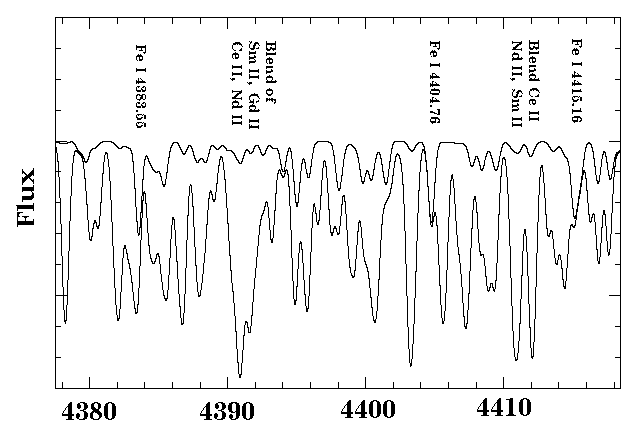
The upper spectrum was made assuming solar abundances, but with the iron-group abundances reduced by a factor of 10. Even so, the strong triplet, 4383, 4404, and 4415A is clearly seen. In the bottom spectrum the abundances of the lanthanide rare earths are increased by four orders of magnitude over solar, as is the case for extreme Ap stars. The iron triplet is still present, but now so overwhelmed by the lines from rare earths that the spectroscopist's practiced eye would not be drawn to them. Probably this is the situation that confronted Przybylski, and it certainly influenced the my attitude. I recall struggling with a tracing that Przybylski had sent us. There were many coincidences with iron-line wavelengths, but in almost every case, it was easier to make the identification with a rare earth line than with iron. The situation was just as Przybylski and Kennedy had described in their 1963 paper. I recall looking at the welter of rare-earth identifications and being reminded of Judy Garland's famous line from the movie, The Wizard of Oz: We're not in Kansas any more.
The true complexity of HD 101065 is not shown by Figure 2, because the resolution of the spectra was degraded to conform to actual spectra studied in 1997 by Gautier Mathys and me. In the spring of 1998, Gautier sent me new spectra (second series) with much higher resolution. Figure 3 shows the same region as Figure 2, but this time with all of the lines that exist in nature, as opposed to those that exist in our data bases.
Figure 3: Recent ESO spectra of HD 101065 showing the same region as Figure 2.

The spectrum shown here was obtained by Mathys at ESO in early 1998. The S/N level was very high, although some noise was generated in our reproduction shown here. Virtually all of the features are real. The synthetic spectra above would certainly appear ``busier'' if their resolution had not been degraded. But there are many features in the stellar spectrum that do not correspond to wavelengths in our data base, as we will explain in more detail.
The next figure shows the contrast in the spectrum of HD 101065 and a strong-lined, cool Ap star Beta CrB whose spectrum is rich in lines of iron and chromium as well as the lanthanide rare earths cerium, gadolinium, and europium. Interestingly, it is rather weak in neodymium and samarium.
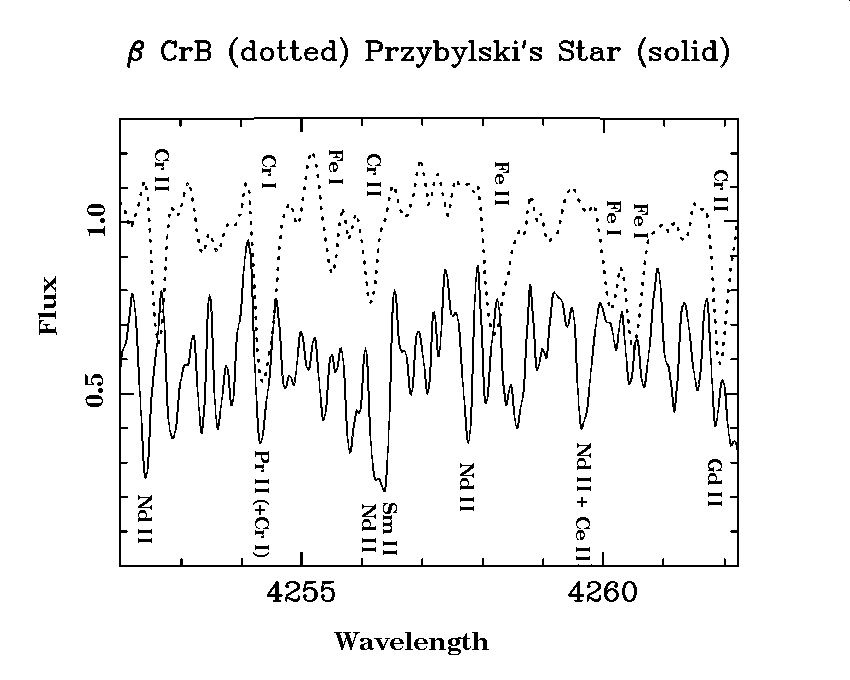
The Beta CrB spectrum (Courtesy of John Landstreet) has been displaced upward by 0.2 units of flux. The strong lines in its spectrum are of iron-peak elements, while those of HD 101065 are due to lanthanide rare earths. Note the strong feature at 4254.3, the position of the strongest Cr I line in this part of the spectrum. It is surely due to chromium in Beta CrB, but in HD 101065, it is probably mostly Pr II, with ``some'' contribution from Cr I.
In the mid 1976's C. R., A. P. Cowley, G. C. L. Aikman, and Hannah Crosswhite made statistical study of wavelength coincidences using measurements from a plate taken of HD 101065 at 10A/mm. We found marginal--but unmistakable--evidence for the presence of spectra of several iron-peak elements, both neutral and first ionized. However, our conclusions generally supported the position taken by Przybylski, that iron is ``underabundant by orders of magnitude.'' He wrote us in late 1976 that he saw ``no reason to oppose your finding that iron peak elements are weakly present in HD 101065.'' Wegner and his coworkers maintained that iron was essentially normal, and simply overwhelmed by the lanthanides.
There was also a question of the effective temperature of the star. Wegner, Kurtz and their coworkers examined strengths of the Paschen lines and IUE spectra and concluded Te was near 7500K. Przybylski had long since concluded from six color photometry that the temperature was much closer to that of the sun, 5780K. If the star were as hot as 7500K, it would fit easily into the category of ordinary pulsating stars, a class now called roAp's or rapidly oscillating Ap stars. But if Przybylski were right about the temperature, this would be much more difficult to maintain.
How could the six-colors of the star be like that of the sun, and the star be as hot as 7500K? An obvious explanation is line blanketing. Atomic absorption lines increase in density toward the violet. The overall color of the star changes with the strength of the atomic lines. The more lines, the redder the star appears. This effect is well known among cooler stars, and has been used to determine abundances of G stars from ordinary UBV photometry. Przybylski recognized the importance of blanketing, but felt that it was compatible with a temperature of about 6200K, only somewhat hotter than the sun.
At this point in time, we really cannot rigorously test the blanketing hypothesis because of a lack of atomic data. However, we have made a little progress.
In the spring of 1997, Gautier Mathys sent me spectra of HD 101065 taken at ESO. They had been made for the purpose of measuring the magnetic field, so there were actually two spectra, made in left and right circular polarizations, which we added together before doing a line-identification and abundance study. The results are published in Astronomy and Astrophysics, Vol. 339, p. 165 (1998), and completely vindicate the point of view taken by Wegner, Petford, Kurtz and their coworkers. While the lanthanides are some four or more orders of magnitude overabundant, the iron-group elements are only slightly underabundant. Indeed, the uncertainty was large enough so the analysis was not inconsistent with a solar iron abundance.
The 1997 spectra (First Series) gave a value of -1408 Gauss with an (rms) uncertainty of 50 Gauss. This is somewhat smaller than the value found by Wolff and Hagen in 1976 (-2100 to -2500 Gauss), but perhaps not inconsistent with it. Because of severe blending, uncertainties in determinations of this kind are large.
In the spring of 1998, Mathys sent new spectra of HD 101065 of far higher quality than the ones we had analyzed earlier. Figure 5 shows the constrast.
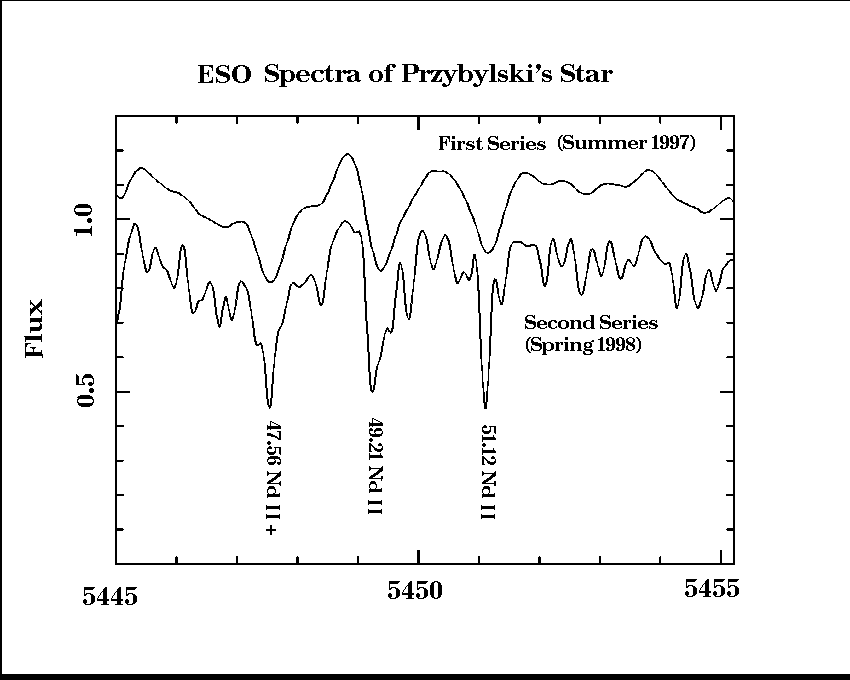
Detailed wavelength measurements and identifications are available for both spectra. Abundance analyses of the new spectra were completed and submitted for publication in December of 1999.
Wavelength measurements for the first series spectra have been available since early 1998 via anonymous ftp at astro.lsa.umich.edu in the account pub/get/cowley/prz. A preprint of our Astronomy and Astrophysics paper may also be found there. Figure 5 makes it clear that the Second Series makes the First obsolete. Wavelengths and identifications for the Second Series may be found here for the region above 5000A. The measurements from 3959 to 5000A were studied by Dr. W. P. Bidelman. A list of the measured wavelengths and identifications is now available.
We can summarize firm results from the the new spectra as follows:
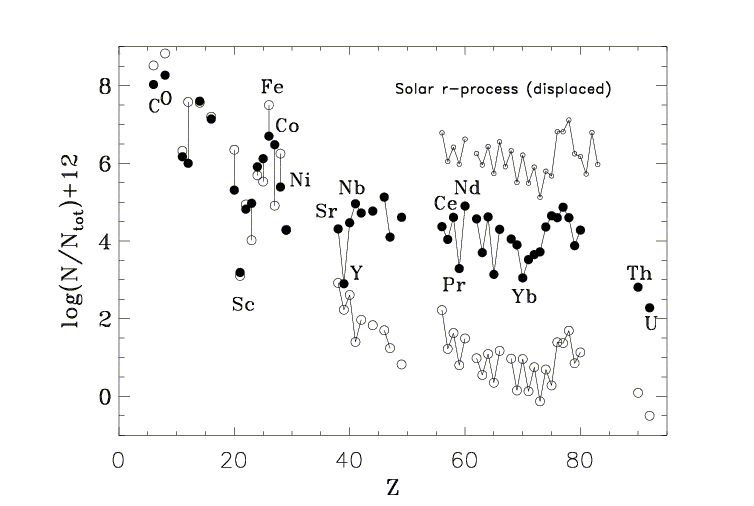
Filled circles are for HD 101065, open circles are the standard abundance distribution (SAD, or "solar"). The results (including points for uranium and thorium) look rather like a displaced solar distribution. There even appears to be a shadow of the third r-process peak, though it is displaced one or two units in Z. The solar r-process only abundances are plotted separately, but displaced upward to avoid confusion. Rare violations of the odd-even effect could be entirely due errors, but this remains to be seen. A table listing individual lines, equivalent widths, log(gf)'s, and abundances is now available.
This page prepared by C. Cowley with help from M. Bessel, W. Bidelman, D. Bord, J. Landstreet, G. Mathys, T. Ryabchikova, and G. Wegner. It was last modified 14 September 2000.
Back to Cowley's HomePage.